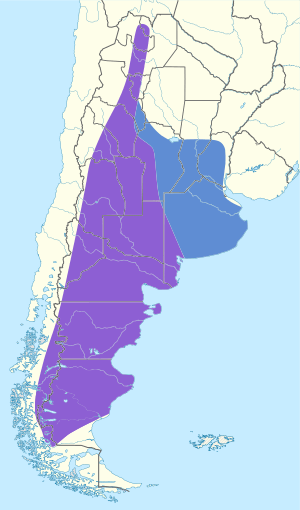Patagonian mockingbird facts for kids
Quick facts for kids Patagonian mockingbird |
|
|---|---|
 |
|
| Conservation status | |
| Scientific classification | |
| Genus: |
Mimus
|
| Species: |
patagonicus
|
 |
|
The Patagonian mockingbird (Mimus patagonicus) is a type of bird that lives in Argentina and Chile. It belongs to the Mimidae family, which includes other mockingbirds and thrashers. This bird is known for its interesting songs and its ability to copy sounds from other birds.
Contents
About the Patagonian Mockingbird
Scientists study how different animals are related. The Patagonian mockingbird is a unique species. Some experts believe it is a "sister species" to the Chilean mockingbird. This means they think these two birds are very closely related.
What Does the Patagonian Mockingbird Look Like?
The Patagonian mockingbird is about 22 to 25 centimeters (9 to 10 inches) long. Males usually weigh between 44 and 62 grams (1.6 to 2.2 ounces). Females are similar, weighing from 44 to 65 grams (1.5 to 2.3 ounces).
Adult birds have a brown top of the head. They have a white stripe above their eye, called a supercilium. A dark line goes through their eye. Their back and upper body are plain grayish-brown, becoming lighter on their rump. Their wings are dark, almost black. When the wings are folded, you can see two thin, light-colored bars. The tail is also dark, but the outer feathers have white edges. Other tail feathers have white tips. The underside of the bird is a buffy gray color, which is lighter on the throat and belly. Young Patagonian mockingbirds look much like the adults, but they have small dark spots on their chest.
Where Do Patagonian Mockingbirds Live?
Patagonian mockingbirds live in northwestern and central Argentina all year round. They also breed in southern Argentina and southern Chile, reaching as far south as the Strait of Magellan. When it's not breeding season, they fly north to central and sometimes northeastern Argentina. This bird has also been seen visiting Tierra del Fuego and the Falkland Islands.
These birds prefer open areas with shrubs and bushes. This includes the Patagonian steppe, which is a large grassland region. In southeastern Argentina, they can also be found in slightly open woodlands. They live at different heights, from sea level up to 1,800 meters (about 5,900 feet) high.
Behavior of the Patagonian Mockingbird
What Do Patagonian Mockingbirds Eat?
The Patagonian mockingbird usually finds its food on the ground. During the breeding season, its main diet is insects. When it's not breeding, it adds fruits and berries to its meals.
Reproduction and Life Cycle
Patagonian mockingbirds breed in January in northern Argentina. In Chile, they breed between October and December. These birds are monogamous, meaning a male and female stay together as a pair. They seem to protect their nesting area from other birds. Family groups often stay together even after the breeding season.
Their nest is shaped like an open cup. It is made from twigs and lined with softer materials. They usually place their nests low down in bushes or other plants. A female Patagonian mockingbird lays between three and six eggs at a time.
Vocalization: The Patagonian Mockingbird's Song
The Patagonian mockingbird is known for its continuous singing. It can sing for long periods from a high perch or hidden within plants. Its song is a "warbling series of varied notes and phrases." This bird is also good at mimicking, or copying, the songs of other bird species.
Conservation Status
The IUCN (International Union for Conservation of Nature) has evaluated the Patagonian mockingbird. They have listed it as a species of "Least Concern." This means that its population is stable and not currently at risk. It is quite common, except in Chile. There are no major known threats to this bird's population.
See also
 In Spanish: Tenca patagónica para niños
In Spanish: Tenca patagónica para niños


